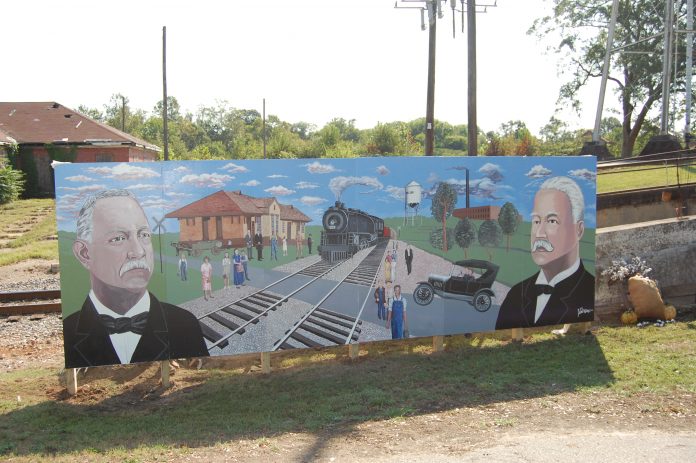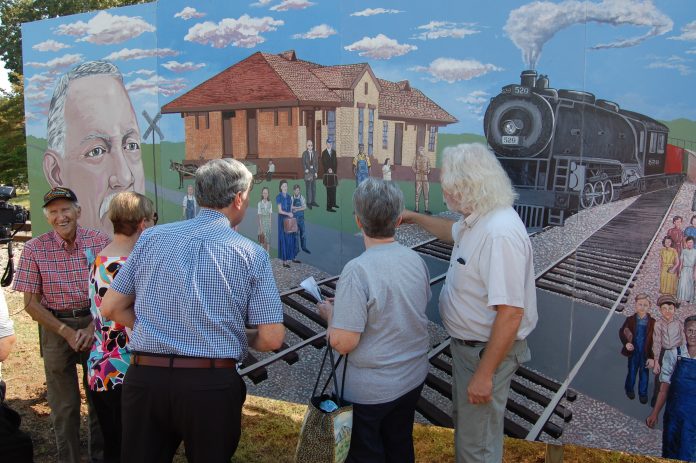 The unveiling and dedication of a historical Pelzer mural was held Saturday (Sept. 11).
The unveiling and dedication of a historical Pelzer mural was held Saturday (Sept. 11).
The mural is located just off Hwy. 8 at the railroad tracks at Betty Boop’s in Pelzer. It depicts Ellison A. Smyth and Francis J. Pelzer, along with other people significant to the history of Pelzer including Gertrude Brown Kelly, a young mother who was killed by a ricochet bullet during the textile strike of 1935. Speakers included Elaine Hunt, Dianne Lollis, Betty Jordan and artist Thomas Addison.
(Featured Photo – Artist Thomas Addison tells Dr. Wayne Fowler and wife Judy about some of the people featured in the historic Pelzer mural. Located behind the mural is the old mill office in the background left, the water tank background right and railroad tracks)
“The purpose of this mural is to promote a historical presence by showing a visual representation of the people who lived and worked in the town and its mills for anyone living or visiting the Town of Pelzer,” Historian Elaine Hunt said,
“Current citizens and visitors should come to appreciate the depth and significance the town played in the lives of our ancestors. From the Charleston investors such as E. A. Smyth and Francis J. Pelzer to the sports heroes, physicians, educators, as well as ordinary people, the mural displays Pelzer’s impact. We sincerely pray that this mural will educate, encourage, and prompt people to appreciate our town and its vital heritage.”
The mural is a gift to the people of Pelzer, both past and present.
Persons involved in the project include: (Pictured L-R) Elaine Tumblin Hunt, Larry Joe Coker, Betty Selman Jordan, Dianne Lollis, Thomas Addison and the Pelzer Heritage Commission.
Before unveiling the mural, Elaine Hunt welcomed guests. Larry Joe Coker had the opening prayer. Dianne Lollis led the Pledge to the flag. Betty Selman Jordan explained how the mural found a home. Artisit Thomas Addison told about the mural development. Elaine Hut explained the historical significance of the mural.
The mural is located between the parking lot and railroad tracks as Betty Jordan’s shop on Hwy. 8. Jordan told those present, “I wanted to give back to the people of Pelzer.” She said during the discussion of where it could go and be seen, she thought, “My little shop can offer a home for the painting.” “I want us to come together for great things for Pelzer,” she said. “People do love their town.”
Thomas Addison told how he had been encouraged years ago, by Doris Cole and others, to use his talents to help promote the community. He explained that Elaine Hunt was the “visionary” for what should be on the historic mural and Betty Jordan wrote a check for supplies to get started. Addison worked on the sic panel mural in his garage. Palmetto art teacher Greg Davis, who has experience with several outdoor murals in Williamston, offered valuable tips, Addison said.
He said he wanted the setting of the painting to look like in was in 1925. It includes 26 people, about but four are real people, everybody knew or everyday people in Pelzer, “or my family,” he said.
Addison said his parent, grand parents and great grand parents were a part of the Pelzer community. “I have a lot invested in the project,” he said.
He said he created a scene that included everything Elaine Hunt wanted including Smyth and Pelzer, who are prominiently depicted on each side of the mural along with the mill, old depot, a train and Pelzer people.
He said the scene is from the depot looking back toward the mill and show things that “realistically could have seen” at the time. It shows the water tank, mill towers, a train, people, merchants, the way they would have looked in 1925.
Addison said there were great advances and innovations at the mills that had never been done before. There was also a darker side which came to a head in the 1930s, with child labor, a textile strike in which a lady was accidentally shot. He mentioned Thomas Edison who played a part in Pelzer’s history, with the mill being the first to run off electricity over extended power lines from a hydro generating plant down river.
Elaine Hunt presented historical background information on people in the mural.
Francis J. Pelzer was born in Charleston SC on April 9, 1826. A pioneer in the fertilizer industry, he helped organize the Pelzer Manufacturing Company in 1881. He and his family traveled between Charleston and the upstate each year by train.
Ellison Adger Smyth was born in Charleston SC in 1847. He became President of the Pelzer Manufacturing Company in 1881 and moved to the Williamston area build a cotton mill with a town to support the company. He moved his family to Greenville and traveled to and from Pelzer on the local P&N railroad. Mural figures include E. A. Smyth and F. J. Pelzer.
At the beginning of the Pelzer cotton mill, the cost of transporting cotton was extremely high. As more mills were built, industry leaders began to lobby for cheaper freight costs as well as more train access to their mills. In 1881, Pelzer was first served by the Columbia and Greenville Railroad just a short distant away. The Piedmont and Northern Railroad, built through Pelzer around 1910, came close to the lower mills. It carried
Trains played an important role in the growth of Pelzer and other cotton mill towns, at the time, transporting passengers and cotton. Mural figures include Piedmont & Northern Train, Depot, Betty Looper, Sarah E. Looper, and Randy Looper
The new Pelzer cotton mills increased the price of cotton by providing farmers with a ready buyer for cotton while increasing the price of farmland. In addition, farm families sold produce, milk, eggs, fruit along with other farm-raised items. Mural figures include John Addison and Marshall A. Looper.
Pelzer had a free public school from early 1881 with the mill company providing buildings, teachers, and the latest equipment. Smyth opened the school to any child who lived in the area. Mural figures include educators John Phibbs and R. M. Stone.
In the spring of 1935, Pelzer experienced a worker strike creating an armed and divided town. On September 3 as workers crossed picket lines to enter the mills to work, gunfire began. When the battle ceased as many as twenty people were injured and one person was dead, Gertrude Brown Kelly. She neither worked in the mill nor was a striker but a mother of two young girls who came to see about her husband who was on the picket line. She died just feet from the mural location, behind the concrete wall, from a ricocheting bullet. Mural Figures include Gertrude Brown Kelly.
Young children were employed from 1882 until after the 1936 Child Labor Law prevented anyone under the age of sixteen from being employed. Mural Figures include Elvin Tumblin, Wayne Garrett, James A. Addison, Christopher Columbus “Lum” Wilson, other unidentified black workers.
Pelzer from its earliest days had qualified health care providers, drug stores, and dentists. Mural Figures include Dr. William H. Dendy
Pelzer mills supported sports programs for its workers and the youth of the town. The mill paid for sports programs and employees to run the programs. Pelzer produced many outstanding and well-known sports stars. Mural Figures include Earl Wooten, Eckie Jordan, and Bill Hopkins.
Women workers filled various jobs in both production and offices. Many times, they appeared in advertisements promoting the products produced in the local mills. Mural Figures include Mrs. Carl Barnwell, Kat Austin, Roberta Fowler, Mattie Lee McDougal.
During war times, Pelzer natives freely joined US military ranks. Mural Figures include James A. Addison and Paul E. Ragsdale.
More information on the mural people and their stories will be posted under Pelzer History on The Journal website at www.thejournalonline.com
















